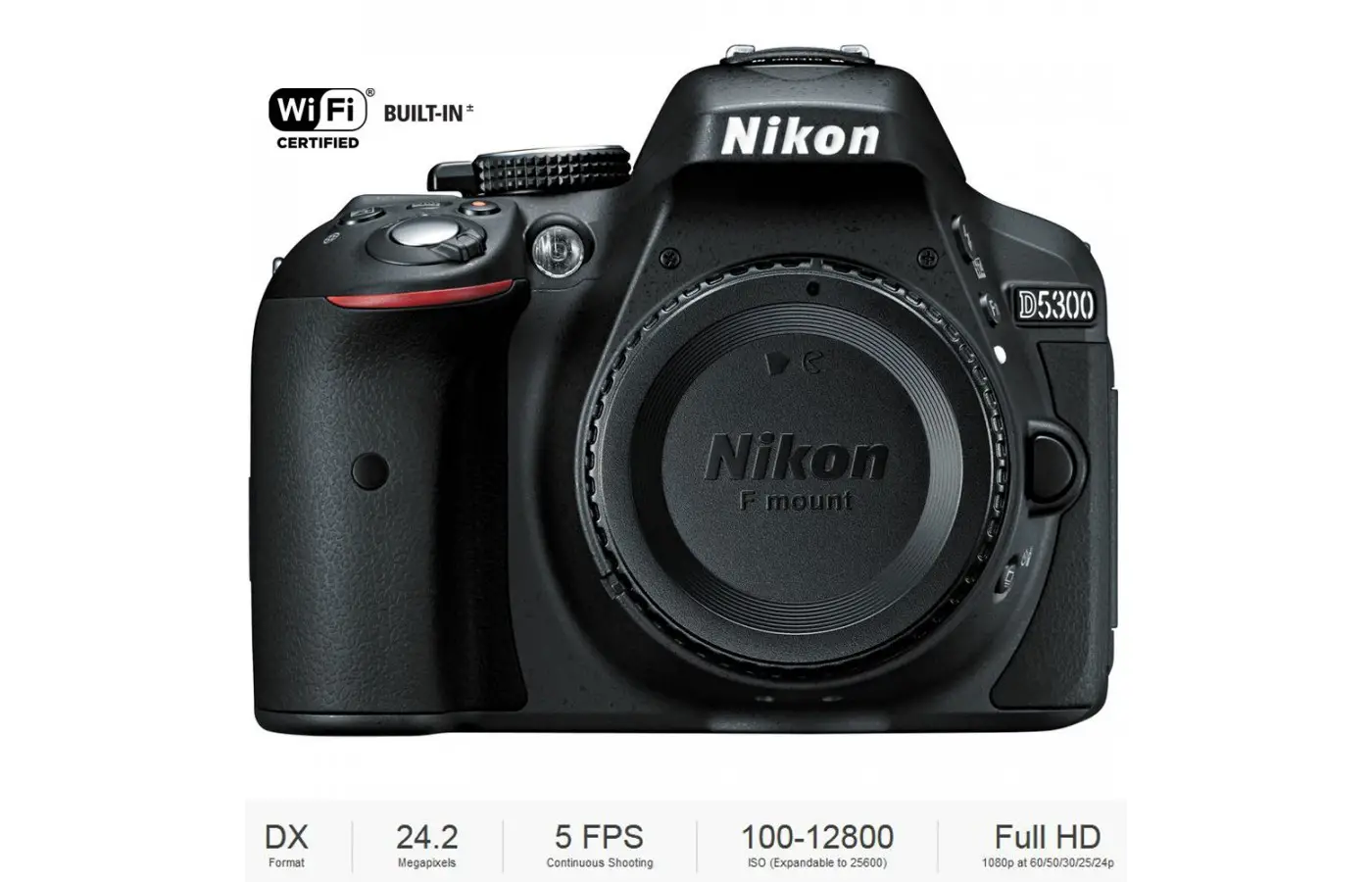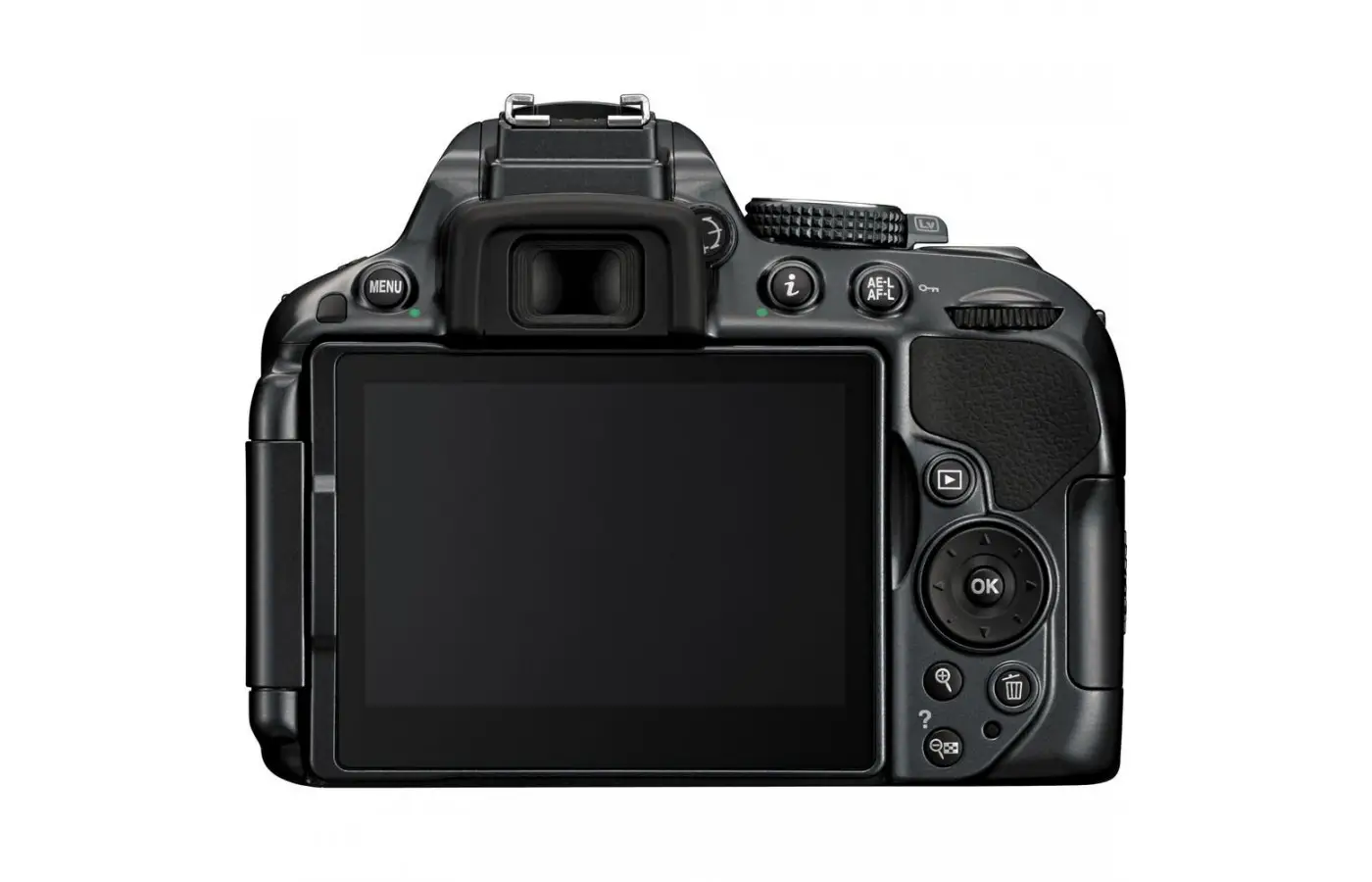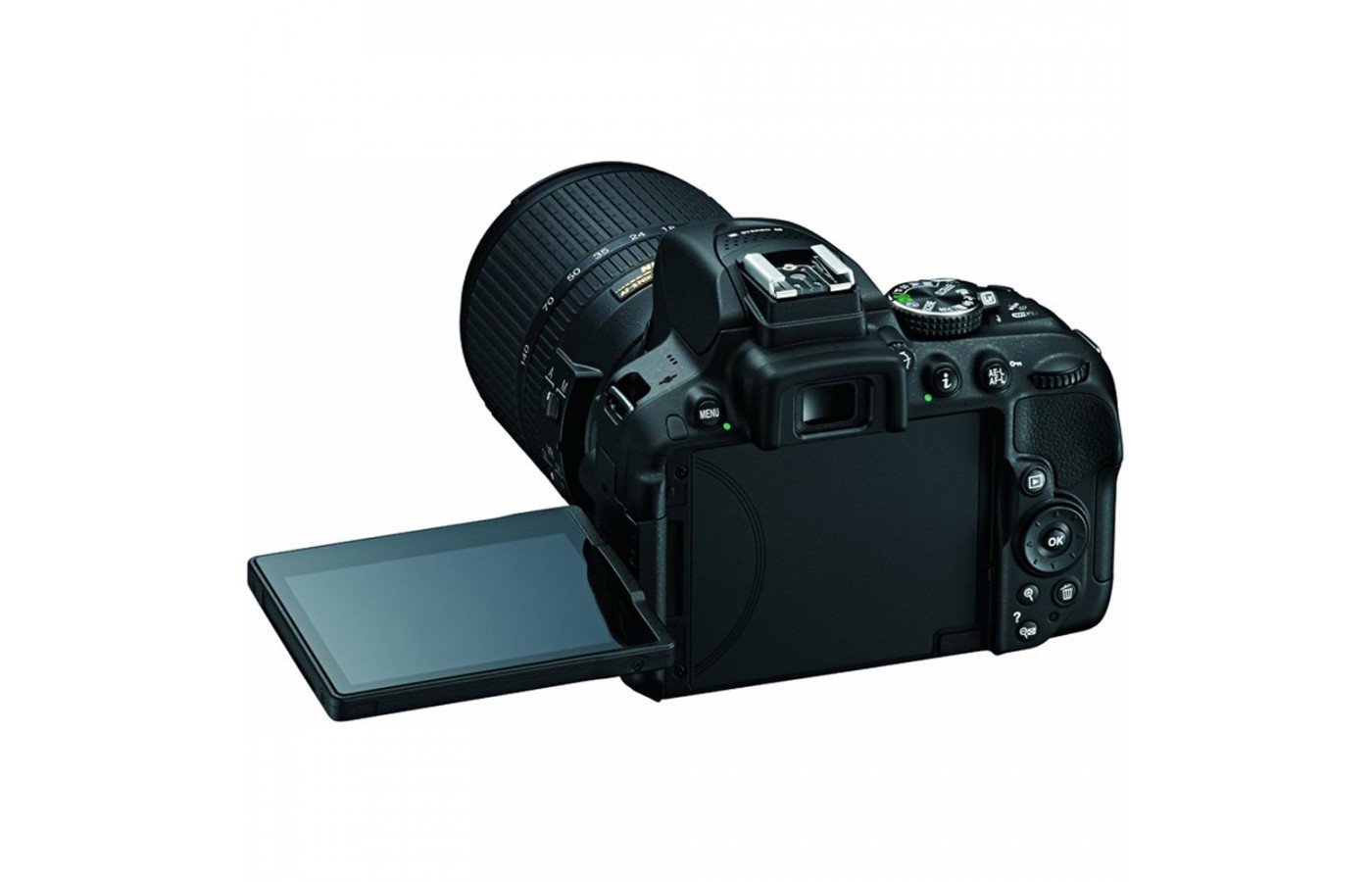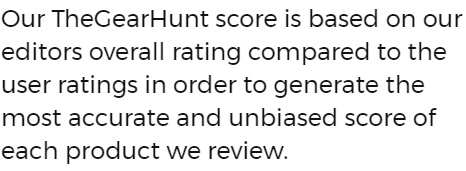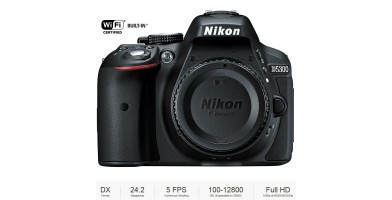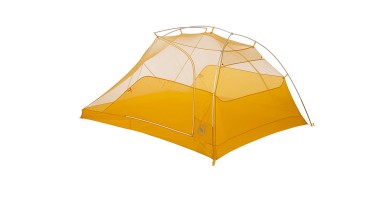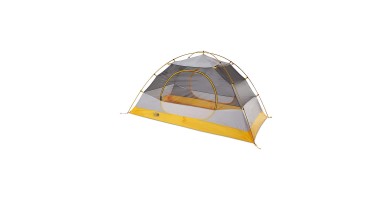Nikon D5300
Nikon D5300 Review Facts
The Nikon D5300 is an advanced beginner camera. It falls between the entry-level and enthusiast-targeted camera. New features include built-in Wi-Fi. A fully articulated display, 1080/60p HD video recording, and 24-megapixels APS-C DSLR.
Reviewers assigned ratings of nine out of ten for Features and eight out of ten for Design, Image Quality, and Performance. The excellent feature set, fast performance, and excellent photo quality are improvements to the already great D5200 camera.
Editor's Pros & Cons
Pros
- A great feature set
- Can be synced with a smartphone
- Excellent build quality
- Excellent photo quality
- Decent continuous shooting rate
- Little high ISO noise
- Low price tag
- Rotating display with excellent resolution
- Speedy performance
- GPS and Wi-Fi capabilities
Cons
- Default settings need improvement
- Disappointing kit lens
- Disappointing Wi-Fi performance
- No touchscreen
Accessories
Useful accessories needed for capturing amazing videos and photos are available in a Professional Accessories Kit that includes a 72’ tripod, Camera Case, two ENGEL 14 and EN-EL14a Batteries and Charger, and 128 SD Memory.
The memory card is perfect for professionals who want to maximize post-production workflow. It is twice as fast as a standard SDHC card. The memory card enables the user to take pictures and full HD 1080p videos and transfer the files quickly with a speed of as much as 80MB per second. It is the ideal DSLR camera memory card.
The memory card is perfect for professionals who want to maximize post-production workflow. It is twice as fast as a standard SDHC card. The memory card enables the user to take pictures and full HD 1080p videos and transfer the files quickly with a speed of as much as 80MB per second. It is the ideal DSLR camera memory card.
Design
The design tweaks made to the D5200 make for a logically laid-out, comfortable camera. It is lighter and smaller with more grip room. The packed mode dial sits on the camera’s top-right shoulder. It has the standard modes - manual, semi-manual, and automatic.
Extending from the dial is a Live View toggle switch. The exposure compensation, info, and record buttons are behind the power switch and shutter button combination. The back controls are a typical fashion arrangement.
Most shooting settings adjustment is made with the information edit button that brings up an interactive information display. The drive-mode button is a bit smaller. It is hard to feel. The location has been changed to a place on the side which did not improve its functionality.
The navigation multi-controller is harder to manipulate than the previous model. With its flaws, the camera delivers streamlined shooting. A newly developed sensor is another tweak of the D5200. There are some eye-catching improvement areas, but a lot of the D5200 specifications remain.
The 39-point AF system is the same. It utilizes a multi-cam sensor module, namely the Multi-CAM 4800DX AF. It copes well with moving subjects due to 3D focus tracking. The 39-point system is in line with the DSLR competition, but a 51-point system would have been an improvement. The EXPEED 4 image processing engine was a newly developed processor used in the D5200.
The trusty Nikon 2016-pixel metering set-up is paired with the Nikon Scene Recognition System for even exposure under various shooting conditions. An improved LCD screen is 3.2 inches and has an impressive resolution of 1037k dots. Unfortunately, the display lacks touchscreen functionality.
Extending from the dial is a Live View toggle switch. The exposure compensation, info, and record buttons are behind the power switch and shutter button combination. The back controls are a typical fashion arrangement.
Most shooting settings adjustment is made with the information edit button that brings up an interactive information display. The drive-mode button is a bit smaller. It is hard to feel. The location has been changed to a place on the side which did not improve its functionality.
The navigation multi-controller is harder to manipulate than the previous model. With its flaws, the camera delivers streamlined shooting. A newly developed sensor is another tweak of the D5200. There are some eye-catching improvement areas, but a lot of the D5200 specifications remain.
The 39-point AF system is the same. It utilizes a multi-cam sensor module, namely the Multi-CAM 4800DX AF. It copes well with moving subjects due to 3D focus tracking. The 39-point system is in line with the DSLR competition, but a 51-point system would have been an improvement. The EXPEED 4 image processing engine was a newly developed processor used in the D5200.
The trusty Nikon 2016-pixel metering set-up is paired with the Nikon Scene Recognition System for even exposure under various shooting conditions. An improved LCD screen is 3.2 inches and has an impressive resolution of 1037k dots. Unfortunately, the display lacks touchscreen functionality.
Connectivity
Significant improvements were made to the camera’s connectivity. No longer does a separate adapter have to be purchased to five the D5300 Wi-Fi functionality. It has a built-in Wi-Fi receiver. Transferring images wirelessly from the camera to tablets or smartphones is possible.
A free app is used to control the camera wirelessly. The sensor features the 24.2MP resolution and retains in APS-C dimensions of the D5200. The sensor sees the removal of the anti-alias filter which causes the D5300 to deliver better levels of clarity and sharpness when compared to its predecessor. The new sensor features an ISO range that covers 100-12,800 which is larger than the 100-6400 of the previous model.
A free app is used to control the camera wirelessly. The sensor features the 24.2MP resolution and retains in APS-C dimensions of the D5200. The sensor sees the removal of the anti-alias filter which causes the D5300 to deliver better levels of clarity and sharpness when compared to its predecessor. The new sensor features an ISO range that covers 100-12,800 which is larger than the 100-6400 of the previous model.
Performance
It typically produces sharp photos having 500 excellent color reproduction. The camera delivers sharper images than the majority of cameras in the class. JPEG images are perfect. The high resolution gives more detail. Rising noise is not a deterrent. In well-lit areas, ISO 3200 is still quite good, without proper lighting there is a lot of detail degradation. Many ISO 6400 shots are usable, even if printed to 13 x 19.
Raw shooting is recommended when making subsequent adjustments. Noise reduction results and JPEG processing cannot be improved at any ISO sensitivity. Nikon default settings deliver an excellent balance between pop and accuracy with control and saturation slightly boosted but sufficient enough to produce egregious clipping in highlight or shadow areas or wholesale hue shifts. Underexposure tendency is a more significant matrix metering issue. It makes sense to underexpose because there does not appear to be much recoverable highlight detail. For those bothered by underexposure, it is easy to fix by switching metering schemes or exposure compensation.
The video has fewer problems with aliasing and more than models of competitors. Darker exposure tends to block up in shadow. The autofocus system is the same as the D5200, but the image-processing chips were bumped to the next generation. Slightly better performance results. Like the D5200, slow lens driving is the bottleneck of autofocus speed. The 18-140 kit lens does not solve the problem. It is fast enough for family or personal photography.
It takes approximately 0.3 seconds to power, focus, and shoot. In excellent or inadequate lighting conditions it takes about 0.6 seconds to refocus and shoot. The most notable improvement is the low-light autofocus. It takes 0.2 seconds for two sequential JPEGs. For raw images, there is a slight increase to 0.3 seconds. When the flash is enabled, it takes 0.7seconds. The D5300 matches the D5200 5.1 feet per second continuous shooting performance for unlimited JPEGs.
The raw burst is still a disappointing six frames for 4.7 feet per second. Live View autofocus is frustratingly slow. The default wide-area AF is too big. A lot of shots that are incorrectly focused as a result. The AF pulses when shooting video. The updated viewfinder is respectable for the class of camera. It also has a larger, higher-resolution LCD that is excellent. A 39-point autofocus system that is high-density, an image sensor lens with 24.2-megapixel DX-format CMOS and nine cross-type sensors earn the camera a position on the high end of the Nikon cameras spectrum.
The camera inherited a lot of impressive functionality from its predecessor and has a remarkable focus system that offers a range of coverage sufficient across the frame. Impressive focusing speeds are hindered when lighting conditions are low. They tend to be a little slower. When shooting in Live View, the camera performs poorly. Contrast detection AF is used for Line View. The flipping of the mirror process to get it out of the way for focus lock is a sluggish experience. A D5300 highlight is the 3D tracking mode that enables sharpness presentation of images throughout a burst of continuous images. The D5300 can shoot stunning footage with the capabilities of the full-HD 10,800 video recording, and a stereo microphone is built-in. Shots can be shared and geotagged with GPS and Wi-Fi connectivity.
Raw shooting is recommended when making subsequent adjustments. Noise reduction results and JPEG processing cannot be improved at any ISO sensitivity. Nikon default settings deliver an excellent balance between pop and accuracy with control and saturation slightly boosted but sufficient enough to produce egregious clipping in highlight or shadow areas or wholesale hue shifts. Underexposure tendency is a more significant matrix metering issue. It makes sense to underexpose because there does not appear to be much recoverable highlight detail. For those bothered by underexposure, it is easy to fix by switching metering schemes or exposure compensation.
The video has fewer problems with aliasing and more than models of competitors. Darker exposure tends to block up in shadow. The autofocus system is the same as the D5200, but the image-processing chips were bumped to the next generation. Slightly better performance results. Like the D5200, slow lens driving is the bottleneck of autofocus speed. The 18-140 kit lens does not solve the problem. It is fast enough for family or personal photography.
It takes approximately 0.3 seconds to power, focus, and shoot. In excellent or inadequate lighting conditions it takes about 0.6 seconds to refocus and shoot. The most notable improvement is the low-light autofocus. It takes 0.2 seconds for two sequential JPEGs. For raw images, there is a slight increase to 0.3 seconds. When the flash is enabled, it takes 0.7seconds. The D5300 matches the D5200 5.1 feet per second continuous shooting performance for unlimited JPEGs.
The raw burst is still a disappointing six frames for 4.7 feet per second. Live View autofocus is frustratingly slow. The default wide-area AF is too big. A lot of shots that are incorrectly focused as a result. The AF pulses when shooting video. The updated viewfinder is respectable for the class of camera. It also has a larger, higher-resolution LCD that is excellent. A 39-point autofocus system that is high-density, an image sensor lens with 24.2-megapixel DX-format CMOS and nine cross-type sensors earn the camera a position on the high end of the Nikon cameras spectrum.
The camera inherited a lot of impressive functionality from its predecessor and has a remarkable focus system that offers a range of coverage sufficient across the frame. Impressive focusing speeds are hindered when lighting conditions are low. They tend to be a little slower. When shooting in Live View, the camera performs poorly. Contrast detection AF is used for Line View. The flipping of the mirror process to get it out of the way for focus lock is a sluggish experience. A D5300 highlight is the 3D tracking mode that enables sharpness presentation of images throughout a burst of continuous images. The D5300 can shoot stunning footage with the capabilities of the full-HD 10,800 video recording, and a stereo microphone is built-in. Shots can be shared and geotagged with GPS and Wi-Fi connectivity.
Image Quality
It is the least expensive camera to use a sensor that did not have an OLPF (Optional Low-Pass Filter). For its price class, excellent photo quality is delivered by the D5300. It does not have the top tonal range.
It does not have an anti-aliasing filter which gives it an edge in resolution. The difference in resolution is subtle. Improvements in the potential quality of a critical image are not always seen in mid-range models.
A beefed up video mode is offered by the D5300. A true 1800/60p HD video is now possible. Photographers and videographers find the slightly widened, fully-articulated LCD screen having 1.04 million dots, very attractive.
Images are noticeably better when compared to D5200 ISO sensitivity. They look sharper but are not less noisy. The lack of an anti-aliasing filter for the sensor call causes images to retain excellent sharpness. The video is better than acceptable for personal use. It has no artifacts usually seen with OLPF-free sensors.
It does not have an anti-aliasing filter which gives it an edge in resolution. The difference in resolution is subtle. Improvements in the potential quality of a critical image are not always seen in mid-range models.
A beefed up video mode is offered by the D5300. A true 1800/60p HD video is now possible. Photographers and videographers find the slightly widened, fully-articulated LCD screen having 1.04 million dots, very attractive.
Images are noticeably better when compared to D5200 ISO sensitivity. They look sharper but are not less noisy. The lack of an anti-aliasing filter for the sensor call causes images to retain excellent sharpness. The video is better than acceptable for personal use. It has no artifacts usually seen with OLPF-free sensors.
Features
The D5300 features a 24MP sensor and an articulated rear LCD. It has more physical controls than a beginner's camera but not the professional grade AF system and twin-dial interface of higher-market, more customizable cameras.
Useful features that can be easy to miss are built-in GPS and Wi-Fi. Both features are firsts for Nikon DSLR cameras. The battery life has increased. D5300 offers 600 shots, which is 100 more than the D5200.
When GPS or Wi-Fi is used, the amount of shooting time is shortened. The D5300 update is iterative. It provides only a few features that the predecessor did not have. A few core specifications have been updated.
There is not a very significant difference between the two models. When compared to the competition, the Nikon D5300 offers a sensor with higher resolution, more AF points, and can shoot 1080/60p video. Built-in GPS and Wi-Fi are also included.
Two control dials would also be beneficial. Nikon uses them on more expensive models, while some competitors offer them at this price point. Amazon well the camera for $374. When compared to competitors D5300 offers a sensor with higher resolution, more AF points, and can shoot 1800/60p video. Improved body design has a slightly larger viewfinder. The higher-resolution LCD is bigger.
A stereo microphone is incorporated. The image processor is a new Nikon Expeed version. It allows better battery life, an extra ISO sensitivity stop, and additional 1080/60p video. HDR painting and toy camera are two new in-camera effects. The camera ships with an 18-140mm f3.5-5.6 kit lens that provides more flexibility than its predecessor's 18-105mm f35.-5.6.
Another welcomed upgrade is a Vari-angle LCD screen that is larger and has an ultra-high resolution. It has a 180-degree swivel. D5000 series cameras have a button front that is a bit crowded.
On paper, the D5300 appears 'fully loaded.' It would be nice if a touchscreen LCD were offered. People have come to appreciate the ability to touch the screen to perform specific actions.
Useful features that can be easy to miss are built-in GPS and Wi-Fi. Both features are firsts for Nikon DSLR cameras. The battery life has increased. D5300 offers 600 shots, which is 100 more than the D5200.
When GPS or Wi-Fi is used, the amount of shooting time is shortened. The D5300 update is iterative. It provides only a few features that the predecessor did not have. A few core specifications have been updated.
There is not a very significant difference between the two models. When compared to the competition, the Nikon D5300 offers a sensor with higher resolution, more AF points, and can shoot 1080/60p video. Built-in GPS and Wi-Fi are also included.
Two control dials would also be beneficial. Nikon uses them on more expensive models, while some competitors offer them at this price point. Amazon well the camera for $374. When compared to competitors D5300 offers a sensor with higher resolution, more AF points, and can shoot 1800/60p video. Improved body design has a slightly larger viewfinder. The higher-resolution LCD is bigger.
A stereo microphone is incorporated. The image processor is a new Nikon Expeed version. It allows better battery life, an extra ISO sensitivity stop, and additional 1080/60p video. HDR painting and toy camera are two new in-camera effects. The camera ships with an 18-140mm f3.5-5.6 kit lens that provides more flexibility than its predecessor's 18-105mm f35.-5.6.
Another welcomed upgrade is a Vari-angle LCD screen that is larger and has an ultra-high resolution. It has a 180-degree swivel. D5000 series cameras have a button front that is a bit crowded.
On paper, the D5300 appears 'fully loaded.' It would be nice if a touchscreen LCD were offered. People have come to appreciate the ability to touch the screen to perform specific actions.
Ergonomics
Both ergonomically and visually, the D5300 is very similar to its predecessor. It is hard to tell the D5200 and D5300 apart at first glance. The D5300 is a bit lighter and smaller. Its compactness is attributed to a more angular design which is among the most notable differences.
The camera is stronger in a couple of aspects. The ergonomics of the camera have been improved to reduce camera shake and enhance the user's grip. The hand-grip is slightly more substantial which contributes to the solid feel in hand.
The feel of the camera makes it more comfortable to handle. Despite the compact feel, the camera is 20 grams lighter. The excellent features of the older version have not been compromised.
The D5300 better delivers stunning shoots with the new, more stable design. A button arrangement configured around a larger LCD has small buttons that make the camera slightly smaller without compromising comfort.
The new arrangement allows a bonus. A larger thumb grip is fitted on the back of the left shoulder on the top of the playback button and minimized d-pad controls. It is still larger than less powerful entry-level cameras.
The camera is stronger in a couple of aspects. The ergonomics of the camera have been improved to reduce camera shake and enhance the user's grip. The hand-grip is slightly more substantial which contributes to the solid feel in hand.
The feel of the camera makes it more comfortable to handle. Despite the compact feel, the camera is 20 grams lighter. The excellent features of the older version have not been compromised.
The D5300 better delivers stunning shoots with the new, more stable design. A button arrangement configured around a larger LCD has small buttons that make the camera slightly smaller without compromising comfort.
The new arrangement allows a bonus. A larger thumb grip is fitted on the back of the left shoulder on the top of the playback button and minimized d-pad controls. It is still larger than less powerful entry-level cameras.
Key Features
* 3.2-inch vari-angle LCD monitor has 1.04M dots
* 5 feet per second continuous shooting
* 39-point AF system has nine sensors cross-type
* 1080/60p video recording
* 2016-pixel RGB metering sensor
* Built-in stereo mic
* CMOS sensor has 24.1MP DX-format, without OLPF
* EXPEED 4 processing
* Standard ISO 100-12,800, up to 25,600 expanded
* 5 feet per second continuous shooting
* 39-point AF system has nine sensors cross-type
* 1080/60p video recording
* 2016-pixel RGB metering sensor
* Built-in stereo mic
* CMOS sensor has 24.1MP DX-format, without OLPF
* EXPEED 4 processing
* Standard ISO 100-12,800, up to 25,600 expanded
Bottom Line
The Nikon D5300 is an upper entry-level DSLR that provides an appealing combination of build quality and solid imaging specifications at entry-level price upgraders can afford. The Nikon D5300 is an excellent choice for a general purpose DSLR.
Built-in GPS and Wi-Fi are included. A lot of functionality is borrowed from D5200, but the D5300 is superior to its predecessor. Things are taken to the next level with the 180-degree swivel LCD screen and the comfortable new design. Overall, it is an excellent camera with capabilities that are not disappointing. It is a step behind more expensive full-frame cameras but not inferior regarding image quality.
Built-in GPS and Wi-Fi are included. A lot of functionality is borrowed from D5200, but the D5300 is superior to its predecessor. Things are taken to the next level with the 180-degree swivel LCD screen and the comfortable new design. Overall, it is an excellent camera with capabilities that are not disappointing. It is a step behind more expensive full-frame cameras but not inferior regarding image quality.





